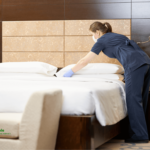Mildew can be an unsightly and frustrating problem in any home. Left unchecked, it can spread quickly and damage walls, fabrics, and other surfaces. Removing mildew takes a bit of effort, but it’s doable if you use the right techniques. Here are some tips for getting rid of mildew effectively.
Table of Contents
What Causes Mildew?
Mildew is a type of fungus that grows in warm, damp environments. It starts off as tiny spores that float in the air and land on surfaces where they germinate and grow. Mildew thrives in areas with excess moisture and little airflow, like bathrooms, basements, and Areas behind furniture. High humidity levels also encourage mildew growth.
Signs of Mildew
The first sign of mildew is usually a musty odour. As it spreads, you’ll notice fuzzy white or grey spots or patches on walls, tile grout, fabrics, leather, paper and other materials. These spots may start off looking like dirt or mould but upon closer inspection are slightly raised and have a velvety texture. Mildew can eventually cause permanent stains and damage if left untreated.
Removing Mildew from Hard Surfaces
On hard, nonporous surfaces like tile, metal, glass and plastic, mildew can be removed with some scrubbing. Here are the steps:
- First, put on gloves and a mask to protect yourself from spores. Open windows or run a fan to allow airflow.
- Mix a cleaning solution of 1 part bleach to 4 parts water in a spray bottle. Make sure the bleach is suitable for the surface.
- Spray or wipe the mildewed areas with the bleach solution, allowing it to sit for 5-10 minutes. This lets the bleach penetrate and kill the mildew spores. Don’t let it dry.
- Scrub vigorously with a stiff brush or sponge to remove all traces of mildew residue. Focus on grout lines and crevices where mildew often lingers.
- Rinse thoroughly with clean water to remove bleach. Allow to air dry.
This process can remove mildew from tile, painted walls, windows, shower stalls, countertops, vinyl flooring, appliances, glass and most other nonporous surfaces. Bleach may discolour some surfaces, so spot test first.
Removing Mildew from Fabrics and Leather
Fabrics like curtains and upholstery can also harbour mildew if damp. Bleach can damage fabrics, so different methods are needed:
- For washable fabrics, launder in the washing machine on a hot setting with detergent and colour-safe bleach. Add white vinegar to the rinse cycle. Tumble dry on high if possible.
- For non-washable fabrics, vacuum off any surface mould gently. Mix equal parts white vinegar and water in a spray bottle and lightly mist the fabric. Let sit briefly before blotting with a clean sponge or cloth.
- Leather can be wiped down with a solution of 1 cup vinegar mixed with 2 cups water. Blot dry with a soft cloth. Stuff newspaper inside damp shoes overnight to absorb moisture.
- If mildew persists after cleaning, the material may need to be discarded. Mold has often taken hold in the padding and backing.
Preventing Mildew Growth
The key to preventing mildew is to control moisture. Here are some tips:
- Use exhaust fans and open windows when showering or cooking to reduce humidity.
- Make sure clothes and towels are completely dry before putting away. Don’t overload closets or hampers.
- Allow airflow behind furniture and appliances. Keep beds pulled a few inches from the walls.
- Repair any water leaks and use dehumidifiers to maintain relative humidity under 50 percent.
- Clean bathrooms and basements regularly with mold killing products.
- Dry out wet spots like windowsills quickly after rain or overflow.
With vigilance and prompt cleaning, mildew can be controlled before causing major issues in the home. If the problem persists, call in a professional mold remediation company. They have industrial-strength chemicals and tools to remove mildew and identify moisture sources.
Affordable Cleaning and Gardening Services is a leading cleaning company in Parramatta that has provided quality cleaning services for over 20 years. Our skilled cleaners use environmentally-friendly products and can help remove stubborn mildew using best practices. Contact us today for a customised cleaning plan for your home or business.
FAQ About Mildew Removal
✓What is the black mold I see in my bathroom?
Black mold is a variety of mildew that grows in very damp areas. Like other mildews, it can be removed with diluted bleach or vinegar solutions. Improving ventilation is also key.
✓Can I use vinegar instead of bleach to kill mildew?
Yes, vinegar is a good non-toxic alternative to bleach for cleaning mildew. Combine equal parts white vinegar and water for an effective anti-mold solution.
✓How can I prevent mildew from coming back after removing it?
Keep the area clean and dry to prevent recurrence. Fix any moisture problems, increase air circulation, and regularly apply mold-inhibiting cleaners. Dehumidifiers and proper ventilation will help.
✓Is it safe to paint or caulk over mildew?
No, mildew will continue to grow under the paint or caulk. Always fully remove mildew and the affected coating before applying fresh paint or caulk. Kill spores first.






